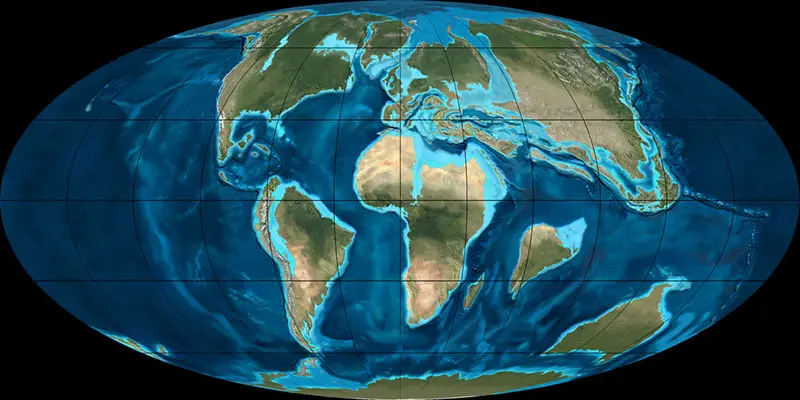†Paromomys (Paromomyidae)
Paromomys ist eine Primatengattung innerhalb der Familie Paromomyidae, deren 5 Mitglieder ab dem frühen Paläogen (Paläozän) im Danium lebten, das vor ungefähr 66 Millionen Jahren begann und bis vor 61,6 Millionen Jahren andauerte. Viele Überreste wurden in Vereinigte Staaten von Amerika (USA) gefunden.
Paromomys ist der Gattungsname zweier ausgestorbener Primatenarten aus der Familie Paromomyidae (Unterfamilie Paromomyinae), die im mittleren Paläozän in Nordamerika verbreitet waren.
Paromomys depressidens
Das Typusexemplar trägt die Bezeichnung U.S.N.M. no. 9546. Dabei handelt es sich um einen Teil des rechten Oberkiefers mit einem Prämolaren und einem Molaren.
| Sammlung | Kommentar zum Fundort | Epoche, Alter | Geologie, Formation | Kommentar zur Sammlung |
|---|---|---|---|---|
| Dragon Canyon | North Horn | Gazin's Locality 2; OMNH V799; UALP 76111, 76112, 7776 | ||
| Kommentar z. Stratigraphie | Kommentar z. Taxonomie | |||
| close to the top of a normal magnetic polarity zone interpreted as C28n, but there is no tie point in the section: see Lucas et al. 1997 | firmly correlated with Wagonroad Upper Horizon, which was included in the list of Tomida and Butler 1980; paleomagnetic data strongly support a correlation between the two horizons descriptions of Robison 1986 do not incorporate the collections reported by Tomida and Butler and Tomida 1982 "Oxyclaenus pearcei" is not discussed by Robison 1986 and I assume it is only present at Wagonroad Upper Horizon Haploconus "inopinatus" is not discussed by Robison 1986 and I assume it is only present at Wagonroad Upper Horizon |
Paromomys maturus
Das Typusexemplar hat die Nummer U.S.N.M. no. 9473. Dabei handelt es sich um einen rechten Unterkiefer mit einem Prämolaren (P4) und einem Molaren (M3) sowie vorderen Alveoli .
| Sammlung | Kommentar zum Fundort | Epoche, Alter | Geologie, Formation | Kommentar zur Sammlung |
|---|---|---|---|---|
| School Well | Fort Union | JHH L6427 | ||
| Kommentar z. Taxonomie | ||||
| entirely from one locality "60 m above the Cretaceous-Tertiary boundary" NISP 7 |
| Physiologie | |
|---|---|
| Gewicht: | ? |
| Schwestertaxa | |
Literatur
G. G. Simpson 1937, The Fort Union of the Crazy Mountain field, Montana and its mammalian faunas. Bulletin of the United States National Museum. 169, p. 1 - 287J. K. Rigby, Jr. 1980, Swain Quarry of the Fort Union Formation, Middle Paleocene (Torrejonian), Carbon County, Wyoming: geologic setting and mammalian fauna. Evolutionary Monographs. 3, p. 1 - 178
M. C. McKenna 1980, Late Cretaceous and Early Tertiary vertebrate paleontological reconnaissance, Togwotee Pass area, northwestern Wyoming. Aspects of Vertebrate History: Essays in Honor of Edwin Harris Colbert, L. L. Jacobs (ed.), Museum of Northern Arizona Press. , p. 323 - 343
K. D. Rose 1981, The Clarkforkian Land-Mammal Age and Mammalian Faunal Composition Across the Paleocene-Eocene Boundary. University of Michigan Papers on Paleontology. 26, p. 1 - 197
G. F. Winterfeld 1982, Mammalian paleontology of the Fort Union Formation (Paleocene), eastern Rock Springs Uplift, Sweetwater County, Wyoming. Contributions to Geology, University of Wyoming. 21:1, p. 73 - 112
J. E. Hartman 1986, Paleontology and biostratigraphy of lower part of Polecat Bench Formation, southern Bighorn Basin, Wyoming. Contributions to Geology, University of Wyoming. 24:1, p. 11 - 63
G. F. Gunnell 1989, Evolutionary History of Microsyopoidea (Mammalia, ?Primates) and the Relationship Between Plesiadapiformes and Primates. University of Michigan Papers on Paleontology. 27:1, p. 1 - 157
J. P. Hunter 1997, Mammals and mollusks across the Cretaceous-Tertiary boundary from Makoshika State Park and vicinity (Williston Basin), Montana. Contributions to Geology, University of Wyoming. 32:1, p. 61 - 114
D. L. Lofgren, J. G. Honey, M. C. McKenna, R. L. Zondervan, E. E. Smith 2008, Paleocene primates from the Goler Formation of the Mojave Desert in California. Natural History Museum of Los Angeles County Science Series. 41:1, p. 11 - 28
E. K. Halverson, J. J. Eberle, M. C. McKenna, R. L. Zondervan, E. E. Smith 2018, A new middle Paleocene (early Tiffanian) mammalian fauna from the Overland Member of the Fort Union Formation, Great Divide Basin, Wyoming, U.S.A. . Rocky Mountain Geology. 53:2, p. 75 - 111, DOI: 10.24872/rmgjournal.53.2.75
